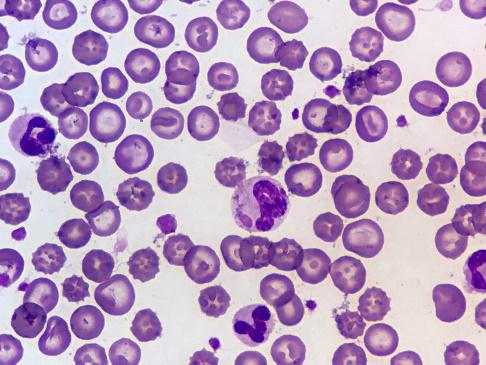
Metachromatic granules can take up the stain from the basic dyes. Explain.
Answer
583.2k+ views
Hint: Here, we will discuss the structure and function of the metachromatic granules that makes them unique in uptake of the stain from the basic dyes making them easy to identify.
Complete answer: Given, metachromatic dyes can take up the stain from the basic dyes. Metachromatic granules are also called as the volutin granules due to the reaction of these granules with the dye while visualizing them under the microscope.
Metachromatic or volutin granules are the intracytoplasmic granules that store the inorganic polyphosphate or inorganic phosphate is stored.
These large inclusion bodies are generally present in the bacteria.
The stored inorganic phosphate can be used in the nucleic acid, polyphosphate backbone, and ATP production that is the energy currency of the cell.
On staining the bacterial cells that have these Metachromatic granules with the basic dye like Methylene blue the entire bacteria appears as blue except the site where these granules are present.

Fig. Metachromatic granules stained with basic dyes
The granules appear red due to the chemical reaction of the phosphate and the basic dyes thereby, helping in the identification of the metachromatic granules inside the cytoplasm.
This effect is referred to as the metachromatic effect as they stain red with methylene blue.
Additional information:The production of the metachromatic granules is used as the identifying criteria when isolating the Corynebacterium sp.
The metachromatic granules have been recently reported to occur in the cytoplasm of Saccharomyces sp. Saccharomyces is a genus of fungi (a eukaryotic organism).
Note: While attempting the question we generally get confused whether the metachromatic effect is seen in the presence of basic dye or acidic dye.
The metachromatic granules appear red due to the reaction between phosphate and the basic dyes which results in formation of a blue colored insoluble product.
Complete answer: Given, metachromatic dyes can take up the stain from the basic dyes. Metachromatic granules are also called as the volutin granules due to the reaction of these granules with the dye while visualizing them under the microscope.
Metachromatic or volutin granules are the intracytoplasmic granules that store the inorganic polyphosphate or inorganic phosphate is stored.
These large inclusion bodies are generally present in the bacteria.
The stored inorganic phosphate can be used in the nucleic acid, polyphosphate backbone, and ATP production that is the energy currency of the cell.
On staining the bacterial cells that have these Metachromatic granules with the basic dye like Methylene blue the entire bacteria appears as blue except the site where these granules are present.

Fig. Metachromatic granules stained with basic dyes
The granules appear red due to the chemical reaction of the phosphate and the basic dyes thereby, helping in the identification of the metachromatic granules inside the cytoplasm.
This effect is referred to as the metachromatic effect as they stain red with methylene blue.
Additional information:The production of the metachromatic granules is used as the identifying criteria when isolating the Corynebacterium sp.
The metachromatic granules have been recently reported to occur in the cytoplasm of Saccharomyces sp. Saccharomyces is a genus of fungi (a eukaryotic organism).
Note: While attempting the question we generally get confused whether the metachromatic effect is seen in the presence of basic dye or acidic dye.
The metachromatic granules appear red due to the reaction between phosphate and the basic dyes which results in formation of a blue colored insoluble product.
Recently Updated Pages
Master Class 9 General Knowledge: Engaging Questions & Answers for Success

Class 9 Question and Answer - Your Ultimate Solutions Guide

Master Class 9 English: Engaging Questions & Answers for Success

Master Class 9 Maths: Engaging Questions & Answers for Success

Master Class 9 Social Science: Engaging Questions & Answers for Success

Master Class 9 Science: Engaging Questions & Answers for Success

Trending doubts
Which places in India experience sunrise first and class 9 social science CBSE

Fill the blanks with the suitable prepositions 1 The class 9 english CBSE

Write the 6 fundamental rights of India and explain in detail

Difference Between Plant Cell and Animal Cell

What is the Full Form of ISI and RAW

What is pollution? How many types of pollution? Define it




